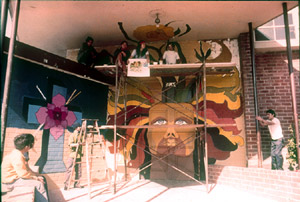
Censored Mural by Chicana Artist Gains New Location in Los Angeles

**Barbara Carrasco’s “L.A. History: A Mexican Perspective” Finally Finds a Permanent Home at the NHM Commons**
After over four decades in storage and limited exhibitions, Barbara Carrasco’s monumental mural ‘L.A. History: A Mexican Perspective’ has found a permanent home at the **Natural History Museum of Los Angeles County** (NHM). Originally commissioned in 1981 to mark the city’s bicentennial, the mural was rejected by the Los Angeles Community Redevelopment Agency (CRA) due to its portrayal of controversial historical events. It has now taken center stage as one of the flagship features of NHM Commons, a new wing of the museum designed to better engage with the public.
### Historical and Cultural Context
Carrasco’s 80-foot-long mural encapsulates the complex and diverse history of Los Angeles, offering a perspective often marginalized in mainstream historical narratives. A proud, brown-skinned woman, modeled on the artist’s sister, anchors the mural, with her flowing locks housing 51 scenes of LA’s layered past. These vignettes spotlight various episodes—celebratory and painful—that have shaped the sprawling metropolis.
From the **Gabrielino/Tongva people**, the original inhabitants of the Los Angeles basin, to events from its Spanish and Mexican eras, and even modern times, Carrasco’s mural serves as a vivid reminder of the many peoples and cultures that built the city. Among these depictions are the construction of LA’s railroads by Chinese immigrants, the whitewashing of David Alfaro Siqueiros’s politically charged mural ‘America Tropical,’ and the personal stories of figures such as **Biddy Mason**, a former enslaved woman who became one of the wealthiest landowners in Los Angeles.
### The Mural’s Journey: Rejection to Recognition
Carrasco was awarded the commission during the city’s bicentennial celebrations, but the CRA requested the removal of 14 out of the 51 scenes, which they deemed too controversial. Among these was a depiction of the **1871 Chinese massacre**, the largest mass lynching in American history, and the forced removal of families in **Chavez Ravine** to make way for Dodger Stadium—both of which remain painful nodes in LA’s fraught racial history.
True to her vision, Carrasco refused to make the requested edits. As a result, the CRA ultimately rejected the mural, and its exhibition in Los Angeles was canceled. Carrasco was left with no option but to store the artwork, with civil rights leader **Cesar Chavez** offering space at the United Farm Workers’ headquarters in Bakersfield, showing the mural’s importance beyond the art world.
The mural has been exhibited only on a few occasions, notably at **Union Station** in 1990 and during the Getty’s **Pacific Standard Time: LA/LA** programming in 2017 at LA Plaza de Cultura y Artes. In 2020, overtures were made to secure a permanent home for the mural, with NHM acquiring it under a grant from the Vera R. Campbell Foundation.
### Design and Community Focus of NHM Commons
Opening this weekend, NHM Commons has been designed with openness and accessibility in mind. The new wing has a glass façade that connects the museum’s interior to **Exposition Park**, inviting the public to engage with the space in ways that extend beyond traditional museum boundaries.
As part of the project’s community-oriented approach, consultations were conducted with a **Native American Advisory Council** to honor the Indigenous roots of the area. The newly designed 25,000 square feet of landscaped gardens incorporate native plants significant to the **Tongva and Gabrielino peoples**, acknowledging their place in LA’s historical tapestry.
### Bridging Art, History, and Activism
Besides the Carrasco mural, NHM Commons will feature an expansive interior, including a theater for educational and entertainment purposes, a café highlighting South LA’s cultural diversity, and exhibits dedicated to **community science initiatives**. Among the headlining attractions is also “**Gnatalie the Green Dinosaur**,” a unique fossil whose hue is derived from celadonite, showcasing the museum’s continued emphasis on natural history alongside its expanded societal focus.
For Carrasco, the inclusion of her mural in such a prominent space represents a long-overdue recognition of the city’s broader and often overlooked histories. As she said during a press event on November 13, “I’m just really grateful.”
### The Importance of Unveiling the Unvarnished Truth
Barbara Carrasco’s refusal to concede to censorship speaks to a broader struggle for truth in historical representation. By refusing to erase or sanitize uncomfortable parts of LA’s past, the artist preserves the integrity of history itself. Curator **William D. Estrada** commended her determination, noting, “She’s too tough, she wouldn’t put up with people trying to eliminate part of her work.”
As a permanent fixture in NHM Commons, the mural will serve as both